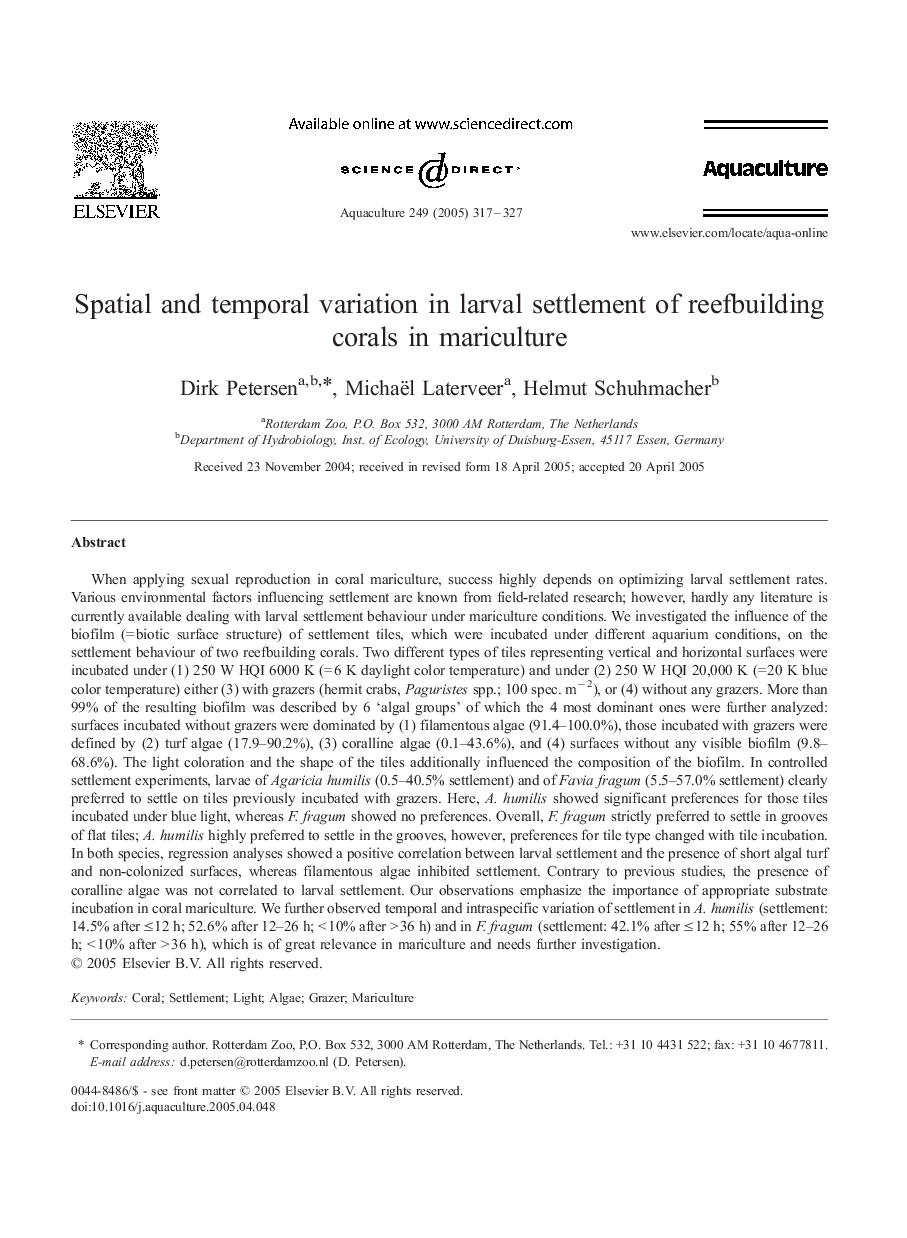| کد مقاله | کد نشریه | سال انتشار | مقاله انگلیسی | نسخه تمام متن |
|---|---|---|---|---|
| 8974698 | 1552993 | 2005 | 11 صفحه PDF | دانلود رایگان |
عنوان انگلیسی مقاله ISI
Spatial and temporal variation in larval settlement of reefbuilding corals in mariculture
دانلود مقاله + سفارش ترجمه
دانلود مقاله ISI انگلیسی
رایگان برای ایرانیان
کلمات کلیدی
موضوعات مرتبط
علوم زیستی و بیوفناوری
علوم کشاورزی و بیولوژیک
علوم آبزیان
پیش نمایش صفحه اول مقاله

چکیده انگلیسی
When applying sexual reproduction in coral mariculture, success highly depends on optimizing larval settlement rates. Various environmental factors influencing settlement are known from field-related research; however, hardly any literature is currently available dealing with larval settlement behaviour under mariculture conditions. We investigated the influence of the biofilm (= biotic surface structure) of settlement tiles, which were incubated under different aquarium conditions, on the settlement behaviour of two reefbuilding corals. Two different types of tiles representing vertical and horizontal surfaces were incubated under (1) 250 W HQI 6000 K (= 6 K daylight color temperature) and under (2) 250 W HQI 20,000 K (= 20 K blue color temperature) either (3) with grazers (hermit crabs, Paguristes spp.; 100 spec. mâ 2), or (4) without any grazers. More than 99% of the resulting biofilm was described by 6 'algal groups' of which the 4 most dominant ones were further analyzed: surfaces incubated without grazers were dominated by (1) filamentous algae (91.4-100.0%), those incubated with grazers were defined by (2) turf algae (17.9-90.2%), (3) coralline algae (0.1-43.6%), and (4) surfaces without any visible biofilm (9.8-68.6%). The light coloration and the shape of the tiles additionally influenced the composition of the biofilm. In controlled settlement experiments, larvae of Agaricia humilis (0.5-40.5% settlement) and of Favia fragum (5.5-57.0% settlement) clearly preferred to settle on tiles previously incubated with grazers. Here, A. humilis showed significant preferences for those tiles incubated under blue light, whereas F. fragum showed no preferences. Overall, F. fragum strictly preferred to settle in grooves of flat tiles; A. humilis highly preferred to settle in the grooves, however, preferences for tile type changed with tile incubation. In both species, regression analyses showed a positive correlation between larval settlement and the presence of short algal turf and non-colonized surfaces, whereas filamentous algae inhibited settlement. Contrary to previous studies, the presence of coralline algae was not correlated to larval settlement. Our observations emphasize the importance of appropriate substrate incubation in coral mariculture. We further observed temporal and intraspecific variation of settlement in A. humilis (settlement: 14.5% after â¤Â 12 h; 52.6% after 12-26 h; < 10% after > 36 h) and in F. fragum (settlement: 42.1% after â¤Â 12 h; 55% after 12-26 h; < 10% after > 36 h), which is of great relevance in mariculture and needs further investigation.
ناشر
Database: Elsevier - ScienceDirect (ساینس دایرکت)
Journal: Aquaculture - Volume 249, Issues 1â4, 12 September 2005, Pages 317-327
Journal: Aquaculture - Volume 249, Issues 1â4, 12 September 2005, Pages 317-327
نویسندگان
Dirk Petersen, Michaël Laterveer, Helmut Schuhmacher,